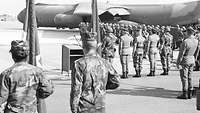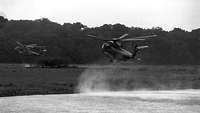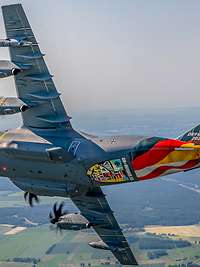Air Defender 23 and its predecessors – exercises for the defense of Europe in the past
Air Defender 23 and its predecessors – exercises for the defense of Europe in the past
- Date:
- Place:
- Germany
- Reading time:
- 4 MIN
During the Cold War, the NATONorth Atlantic Treaty Organization countries and the Warsaw Pact conducted numerous military exercises in order to prepare for potential conflicts in Europe. The annual multinational NATONorth Atlantic Treaty Organization air force exercises included, among others, the Cold Fire exercise. NATONorth Atlantic Treaty Organization’s Carte Blanche air force exercise, however, was a unique event.
First NATONorth Atlantic Treaty Organization exercise reveals terrible outcome
The first air force exercise ever took place in the summer of 1955, without participation of the German Air Force, which was officially established only half a year later. The exercise was called “Carte Blanche”, which means unconditional power — anyone who receives a carte blanche may act at their own discretion without any conditions or restrictions. The exercise lived up to its name and shocked West Germany. “With more than 3,000 aircraft, airmen of eleven nations gambled for life or death at altitudes between 10,000 and 15,000 meters in the sky,” Germany’s news magazine Der Spiegel told readers in issue 29 of 1955. 12,347 sorties were flown, with the outcome that the entire territory of the Federal Republic of Germany and the former German Democratic Republic (GDR) would have been reduced to rubble if nuclear weapons had been employed in an emergency. The strategic concept behind all this – “massive retaliation” – was considered controversial and replaced by the “flexible response” in the mid-1960s.
Deployment exercises demonstrate performance capability
The air forces rarely conducted separate military exercises of their own similar to Air Defender 23. They usually took part in army and navy exercises. The Reforger exercises, which took place from 1969 to 1993 on a regular basis, simulated as realistic combat situations as possible. The Cold Fire air force exercise series also supported major army exercises. During these exercises, the participants tested new tactical procedures as well as operational and strategic concepts. The individual military exercises were named with the number of the year in which they took place, for example Cold Fire 82, Cold Fire 83 and so on. The last Cold Fire exercise took place in 1994. The exercise usually lasted three weeks and was integrated into the Autumn Forge series exercises of the land forces that took place in autumn.
The Reforger exercises — named for the “Return of Forces to Germany” — were large-scale military exercises that were conducted several times a year. The name had its origin in the exercise objective – the return of USUnited States forces to Germany. The most extensive exercise in this series took place at the peak of the Cold War in 1988. Then, transport aircraft carried some 188,000 soldiers and thousands of tons of materiel across the Atlantic in countless sorties. Bulky equipment made its way to Germany by ship.
New concepts, new technology
The Cold Fire exercise series was one of the first exercises in which newly developed aircraft and helicopters had to cope with realistic scenarios under Europe’s special operational conditions and demonstrated their acceptability for service use. And so, starting in 1975, the McDonnell F-4 Phantom II all-weather combat aircraft took part in the exercise for the first time. Within the scope of NATONorth Atlantic Treaty Organization autumn exercise Autumn Forge 87, the first night and all-weather combat capable AH-64A attack helicopters deployed to Europe and Germany. Within the respective exercise areas, the training objective was to counter enemy air raids above the North German Plain, prevail against air strikes carried out by the Warsaw Pact via the Fulda Gap, gain air superiority, and support friendly counteroffensives. At the same time as the Cold Fire exercises took place, the Warsaw Pact often conducted similar air force exercises that assumed provocations by NATONorth Atlantic Treaty Organization. The Cold Fire 84 exercise orders were even spied out by reconnaissance forces of the GDR’s National People’s Army.
Easing of tensions concludes military exercise series
With the end of the Cold War, the scale of the Cold Fire exercise series was reduced. In 1994, one last Cold Fire exercise was organized. It took place in Germany, Belgium, Denmark, the Netherlands and parts of Northeast France and was led by the Allied Air Forces Central Europe (AAFCE) headquarters at Ramstein Air Base.
Meet and cooperate
Hence, the Cold Fire exercise series was an important part of the history of NATONorth Atlantic Treaty Organization exercises during the Cold War. The primary objective was – just as it is today – to improve cooperation and interoperability of the national air forces and enhance the capabilities of pilots and technicians. Today, it reminds us of the threat that existed back then and shows how important it is to be prepared in times of uncertainty and conflict.





